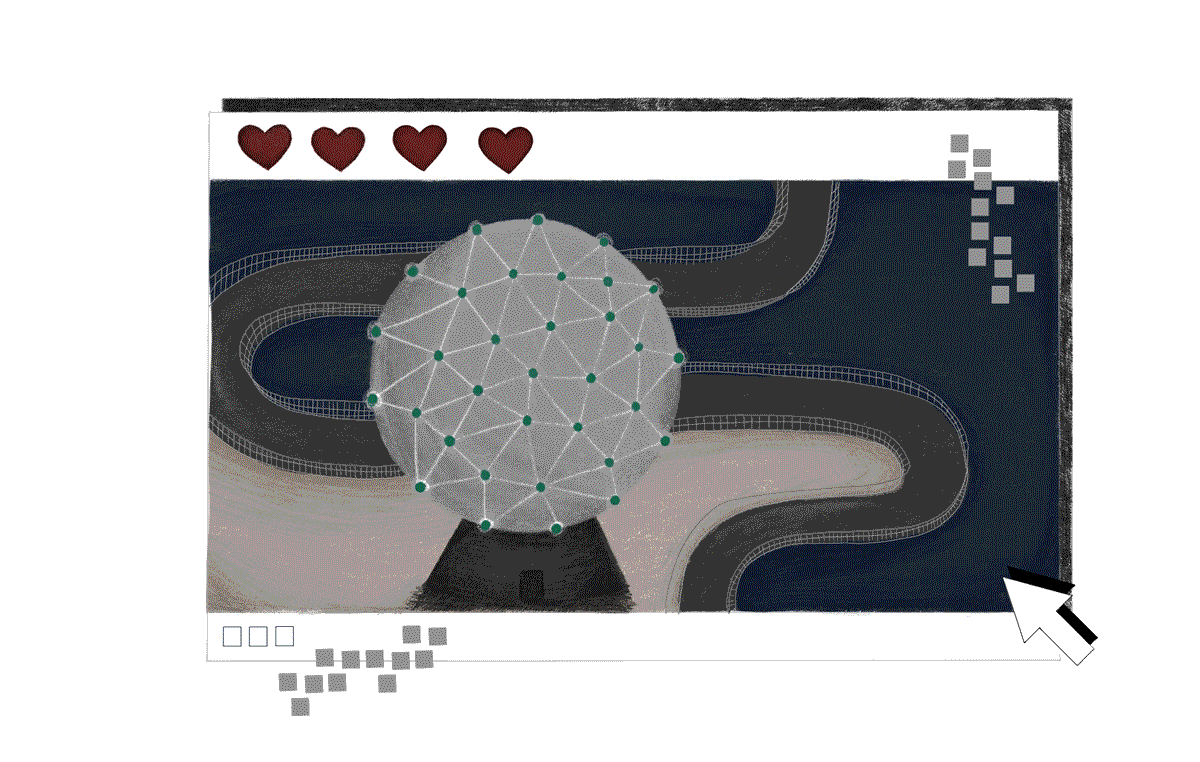Have you ever walked through Gastown and felt a certain upsetting incongruousness? For those unaware, Gastown is part of Vancouver’s downtown eastside, which has historically been the site of some of the city’s most complex social issues with the highest concentration of homelessness and drug use. It is also the site of many of the priciest home design stores, Michelin Star restaurants, and expensive condos in Vancouver. There is discomfort in even using a word so small to describe the situation of the city’s most vulnerable citizens in crisis — those dealing with the ongoing effects of poverty, a lack of resourcing and being surrounded by some of the city’s richest outlets.
This is perhaps why Tails (2023) and Backbone (2021) — a series of games released by developer Eggnut which are set in a dystopian post-noir downtown Vancouver populated by anthropomorphized animals — features Gastown as the site of its most poignant narrative. The level holds nothing back in mirroring the actual neighbourhood, it is inhabited by a mix of characters experiencing homelessness, in mental illness crisis, and resorting to dangerous activities to survive — all against a backdrop of shimmering designer stores both the NPCs and player themselves cannot enter. This is also the opening scene to 2023’s Tails and is the level requiring the most dialogue engagement and physical exploration. If you play both games in quick succession, post-noir downtown Vancouver is the only environment to appear in both, and it is clear these levels were intentionally designed as the centrepiece of the entire series’ gameworld.

At one point while talking to an inhabitant of fictional Gastown, the player speaks with a mechanic who tells us the area feels wrong to him, that Gastown’s ‘niceness’ has a suffocating uncaring quality; “You ever hold something really expensive in your hand and start sweating because you’re afraid you might break it? It’s like that, except around here it’s the expensive thing that’s holding you. And it doesn’t give a shit if you break.” This line is perhaps one of the most nuanced lines of dialogue I have encountered in a game, because it not only sets the tone for the world and story of Tails and its predecessor Backbone, but it connects beyond the 4th wall. It reinforces that Vancouver is not merely an inspiration for the dystopian setting of these games, but is in fact the main subject of the games’ messaging.
In Backbone, the series’ first installment, the player takes on the persona of a raccoon detective, Howard, and is pulled into a web of class corruption, unethical experimentation, and murder. The game garnered attention and acclaim for its beautiful pixel art, soundtrack, and its accurately harrowing depiction of Vancouver. Tails: The Backbone Preludes, expanded the world of Backbone, returning the player to an earlier time within Howard, and other characters’ lives growing up in “the city.” Building on the prior release, the game focused more intently on these character’s most pressing social issues — housing insecurity, corporate exploitation, addiction and classism, to name a few.
The mechanics and narrative of the games differ slightly, and while neither is better than the other in terms of playstyle, together they provide a well-rounded amount of immersion that throughout the series pivots around dialogue and open exploration in stylish and artfully drawn environments. Where in Backbone the player focuses on Howard and his quest to unravel a murder mystery, Tails instead focuses on four different character narratives, altering between different lives and often jumping years at a time between level segments as we watch the characters grow up and the city around them change. Both games feature simple point-and-click style mini-games to break up the walking sim and dialogue-centric portions of each level. Tails particularly has drawn inspiration from indie darling Unpacking through one of its characters Renee, who seems to constantly be packing and unpacking her things in different apartments as she tries to dispel the growing tension between her journalism career and her relationship with her partner who works as a cop. Both games feature the similar city regions — Granville St, the West End, Gastown, and a gated community known as ‘Science City’ among others. The allegorical mapmaking for this last one is clear for those of us from Vancouver — in attempting to keep their map contained, Point Grey and the UBC area have been folded into a fictional region of downtown to integrate the real socio-geographic divides of Vancouver into the game.
While Backbone’s art style set a new bar for pixel games generally, Tails exceeds that bar. It has also integrated optional pauses into the game, wherein we may watch a character sit in the environment and rest, allowing the player to likewise appreciate the art of the background and soundtrack. This ability to sit and enjoy an environment in a serene, 4th wall moment, is a trend seen in other recent releases which have similarly invested heavily in beautifully crafted environments. For instance, Stray, which is a game exploding with vibrant neon colours, warm lighting and comforting fixtures, and gained viral attention for its use of this ‘cozy’ mechanic.
Unlike Backbone which steeps itself in the richness of its mystery plot, Tails focuses on showing the player a deeper view of its environment. There is no mystery to solve and no clues to unpack, simply the offer to explore this world further to deepen our understanding of its mechanisms and how it has affected each character we follow. In each narrative, the game points to the social and institutional issues in each character’s community at the root of their mental, emotional or physical insecurity. Where Backbone paints the portrait of individuals struggling to survive, Tails shows us where that struggle comes from. It positions Vancouver, via its fictional shadow “the city,” as the cause of these characters’ tragic story arcs. In one storyline, we open with a building burning down, making way for new more expensive development to happen with little to no investigation. In another, we watch a friend slowly succumb to addiction under the weight of poverty and limited security until he is fully isolated from his community. Without spoiling too much from the first game, the reality for all these characters is grim, and even though we know this from the onset of Tails, it is still hard to watch this unfold. This is made more difficult due to the game’s choice-driven narrative, which throws the player into a situation where these branching narrative options make them feel as though they can help prevent the events of the first game. Although, ultimately, as we come to the end of each storyline and its predetermined end, we realize we never could. It was the environment, not the individual, that doomed our characters.

From the jazzy soundtrack, to the dark over-narrative, to the seedy visuals — the conventions of the noir genre ooze from both games. Though Backbone and Tails both deliver on the post-noir genre through their narrative structure. Noirs, especially those crossed with science fiction and fantasy, are stories grounded in their grim, often corrupt, worlds. The protagonist — usually a detective — begins their quest for ‘answers,’ due to a catalyzing event such as a murder or a missing person, only to discover along the way that the city and its ‘system’ is to blame. Blade Runner is an archetype of the SF noir genre — the replicant Deckard hunts isn’t the true evil, it’s the Corpo-syndicates and the classist system they are trapped in that are to blame. Backbone and Tails follow these SF noir conventions, catalyzing our entrance into their world with a missing person case — one which quickly spirals into a top-down view of a society that has become entirely fueled by wealth. Much like Blade Runner, Tails and Backbone deliver its audience a similar post-noir moral: when a system runs at the expense of its most vulnerable members, then there’s something wrong with that system.
However, the world of Tails and Backbone are direct mirrors of our Vancouver reality, running in parallel with its recent and ongoing issues, so that post-noir message really and truly hits home. There are real issues in the downtown eastside, there are real buildings burning down to make way for new condos, there is a real ongoing overdose crisis, and there is a real culture of classism in Vancouver driving much of its decision-making. And so, while Tails and Backbone, present us with a beautiful and stylish escapist retreat — and are games replete with interesting mechanics and branching narratives to explore — they are ultimately texts, perhaps even political ones, meant to provoke insight into the city they represent. And, as with many effective political allegories, Tails and Backbone achieve a wide-reaching understanding of their message by embedding it in a story that uses anthropomorphized animals; a storytelling technique commonly known as a beast fable.
Beast fables are often used to convey political messages because the interpersonal relationships of animal groups (prey to predator, large to small) are easily mapped to represent political and social differences between real human groups, while providing a broader more philosophical and morally grounded understanding of the issues at play. Essentially, they are an accessible route to understanding ‘eat the rich’ in the most literal sense. Backbone in particular sets up the beast fable at the core of its political messaging. There is a thread of the story involving animals being eaten by other animals, there are wealth divides along species lines, and there are associations between animal qualities’ and professional endeavours. It’s no coincidence Renee is a fox journalist, Science City is controlled by tool-wielding Apes, and the criminal underground is comprised of predators.
As with Backbone, Tails left me wanting more. The world of Tails is rich with narrative intrigue and instills the player with a desire to explore its intricate environments and story. However, one run of this game took me about 5 hours to complete. Normally this would frustrate me — why set up a physically and narratively complex world, but limit the amount of time and opportunity the player is given to explore and unravel that world. And yet, the short runtime of Tails is nothing but value added. The desire for more I was left with is, in my opinion, intentional and rewarded by the possibility offered through the game’s branching replayable structure. The short-run time lends to the effectiveness of the goal Tails has for its audience. It provokes them to return several times and dig into the nuance of each level in order to fully unpack the cause behind the derailment of each character’s life.
Both Backbone and Tails succeed as typical gaming experiences — they are beautiful, immersive, and provide a form of escapism. However, with their use of allegorical characterization, post-noir narrative structure, and parallels with a real city with real issues, they are, at their core, a grounded form of escapism. A fictional and approachable world that helps us unpack our local and lived experience. Because sometimes, as we are surrounded by a problematic reality, held by it, we forget it’s there; and sometimes we need to view it in abstract to see how bad it really is.


